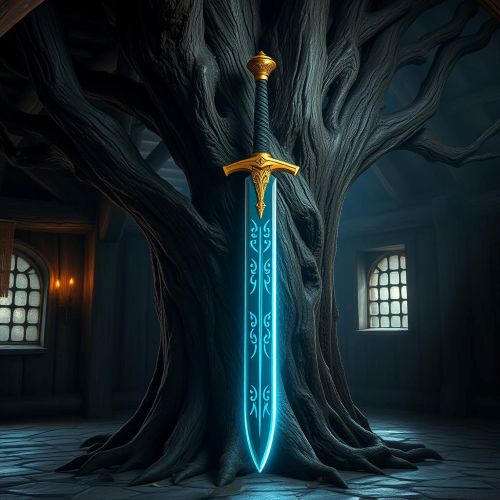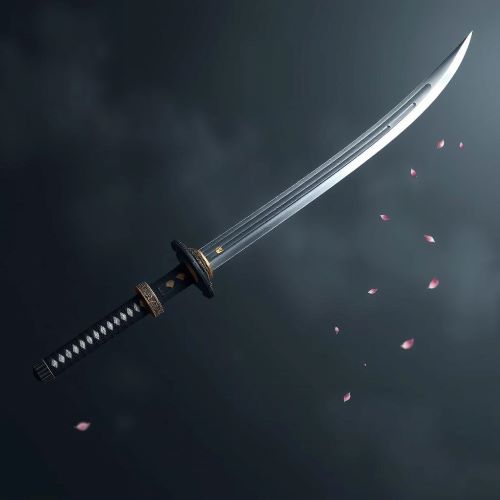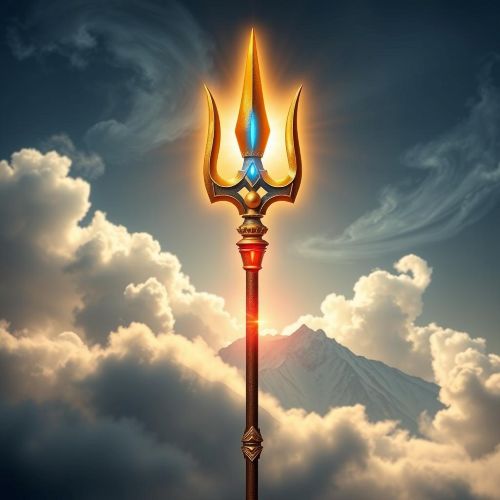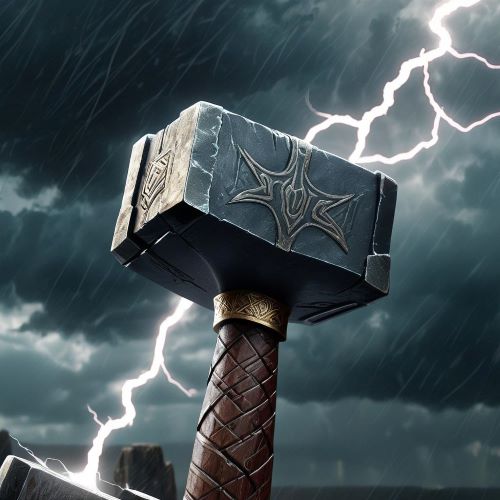Ame-no-Habakiri : The Serpent Slayer
Ame-no-Habakiri
Introduction
Among the legendary weapons of Japanese mythology, Ame-no-Habakiri (天羽々斬)—sometimes written as Ama-no-Habakiri—stands as one of the most storied blades. Revered as a Totsuka-no-Tsurugi, or “sword of ten hand-breadths,” it is best remembered as the weapon wielded by Susanoo-no-Mikoto, the storm god of Shinto belief. This divine sword earned eternal fame in the tale of Susanoo’s battle against the fearsome Yamata no Orochi, an eight-headed, eight-tailed serpent that terrorized the land. Its legend blends symbolism, mythic storytelling, and cultural reverence, ensuring its place among the greatest weapons in Japanese lore. Beyond mythology, Ame-no-Habakiri has inspired popular culture, appearing in manga, anime, and video games, cementing its presence in both ancient tradition and modern imagination.
Origins
The story of Ame-no-Habakiri is preserved in Japan’s earliest written chronicles, the Kojiki (712 CE) and the Nihon Shoki (720 CE). Both texts describe Susanoo’s descent from the heavenly realm after being exiled for his disruptive behavior in the court of the gods. In Izumo Province, Susanoo encountered an elderly couple, Ashinazuchi and Tenazuchi, who had already lost seven daughters to Yamata no Orochi and now faced losing their last, Kushinada-hime. Moved by their plight, Susanoo vowed to slay the serpent in exchange for Kushinada’s hand in marriage.
To ensure her safety during the confrontation, Susanoo transformed Kushinada-hime into a comb and placed her in his hair. He then devised a trap using eight vats of sake, placed behind gates constructed at each of the serpent’s paths. When the colossal Orochi drank the strong liquor, its many heads became drunk and sluggish. Seizing the moment, Susanoo drew Ame-no-Habakiri and struck with divine precision, slicing off each of the serpent’s heads and severing its massive tails.
Within the fourth tail, Susanoo discovered another famous sword, the Kusanagi-no-Tsurugi, which he later presented to his sister, the sun goddess Amaterasu, as a gesture of reconciliation. This act connected Ame-no-Habakiri not only to Susanoo’s victory but also to the imperial regalia of Japan. The name of the sword itself has deep resonance: “Ame” (天) signifies “heaven,” while “Habakiri” (羽々斬) translates as “serpent-slayer” or “snake-cutter,” perfectly reflecting its mythological purpose. Some traditions call it Ama-no-Ohabari or Worochi-no-Aramasa, showing how regional storytelling preserved the weapon’s identity in multiple forms.
In certain versions of the Nihon Shoki, however, it is suggested that Ame-no-Habakiri may have broken during the battle, though the dominant tradition maintains its survival and eventual enshrinement at Isonokami Shrine in Nara Prefecture, where it is venerated as a sacred shintai, or divine object of worship.
Think you know your myths and legends? Dive into the world of ancient stories and test your knowledge with our engaging quizzes on Mythlok!
Powers
As a sword forged in myth, Ame-no-Habakiri is no ordinary weapon but a divine instrument of immense power. Its role in slaying Yamata no Orochi underscores its supernatural ability to overcome forces of chaos that ordinary arms could not touch. The serpent’s immense size—its body said to span valleys and rivers—required a blade imbued with heavenly strength. Thus, the sword symbolizes not only martial prowess but also purification, the triumph of order over destructive forces.
In Japanese religious interpretation, weapons like Ame-no-Habakiri were not just tools of violence but carriers of spiritual potency. The sword’s act of cutting down Orochi is often read as a mythic allegory for taming floods or chaos, with Susanoo acting as a divine hero who restored balance to the world. Unlike Kusanagi, which became a gift and symbol of imperial rule, Ame-no-Habakiri represents direct action and intervention—the blade that actively defeated evil rather than a relic inherited afterward.
Modern depictions in anime and games amplify these qualities. In One Piece, Ame-no-Habakiri is one of the 21 Great Grade swords and is described as capable of “slicing through the heavens.” This echoes its mythological grandeur and reinforces its association with unmatched sharpness, durability, and divine authority.
Owners/Users
In the original Shinto tradition, the undisputed wielder of Ame-no-Habakiri is Susanoo-no-Mikoto, the storm god and brother of Amaterasu. His use of the sword in slaying Yamata no Orochi is the defining moment of its mythological history. No other deity is consistently linked with wielding it in combat, though later ritual and shrine traditions enshrined the sword as a sacred relic accessible to the divine order.
Over time, the sword also took on symbolic roles in Japanese lore, with some accounts linking its spiritual legacy to the gods of thunder and war, such as Takemikazuchi. Its enshrinement at Isonokami Shrine ensured that it was not merely remembered as a weapon but revered as a vessel of divine power and a protector of the people.
In modern storytelling, Ame-no-Habakiri has passed into the hands of fictional characters. In One Piece, it was wielded by Kouzuki Oden, who paired it with the blade Enma in his distinctive two-sword style. Oden used Ame-no-Habakiri to inflict Kaidou’s only known scar, a feat that highlighted the sword’s legendary strength. Later, Oden entrusted the blade to his family, intending it for his son, Momonosuke, as an heirloom. Beyond manga, the sword appears in games like Granblue Fantasy Relink and Phantasy Star Online 2, and in anime such as Symphogear, where it is reimagined as a relic powering the armor of Tsubasa Kazanari.
Instances used
The most significant and enduring use of Ame-no-Habakiri is its role in the slaying of Yamata no Orochi. This myth has become one of the foundational stories of Shinto tradition, encapsulating themes of bravery, divine justice, and the triumph of order over monstrous chaos. The tale also connects the sword to Japan’s imperial mythology through the discovery of Kusanagi, ensuring that Ame-no-Habakiri’s story remains intertwined with the sacred regalia of the nation.
In cultural memory, the sword’s usage did not extend much beyond this mythological moment. Instead, its significance shifted toward ritual and symbolic functions. As a shintai at Isonokami Shrine, Ame-no-Habakiri became an object of veneration rather than a weapon for further battles, embodying its protective and purifying essence for the community.
In popular culture, however, Ame-no-Habakiri continues to “see action.” Its modern reappearances in manga, anime, and games keep its myth alive, showing it in new contexts of battle. Whether slaying kaiju-like monsters in fantasy RPGs or crossing blades with legendary figures in One Piece, each depiction reinforces its reputation as one of the mightiest swords of both myth and imagination.
Frequently Asked Questions
Lorem ipsum dolor sit amet, consectetur adipiscing?
Lorem ipsum dolor sit amet, consectetur adipiscing elit. Praesent convallis vestibulum justo, ac tincidunt nunc vehicula quis. Nullam id dolor quis orci malesuada feugiat. Curabitur aliquet libero at urna ullamcorper, ac ultricies nulla dapibus.
Lorem ipsum dolor sit amet, consectetur adipiscing?
Lorem ipsum dolor sit amet, consectetur adipiscing elit. Praesent convallis vestibulum justo, ac tincidunt nunc vehicula quis. Nullam id dolor quis orci malesuada feugiat. Curabitur aliquet libero at urna ullamcorper, ac ultricies nulla dapibus.
Lorem ipsum dolor sit amet, consectetur adipiscing?
Lorem ipsum dolor sit amet, consectetur adipiscing elit. Praesent convallis vestibulum justo, ac tincidunt nunc vehicula quis. Nullam id dolor quis orci malesuada feugiat. Curabitur aliquet libero at urna ullamcorper, ac ultricies nulla dapibus.
Lorem ipsum dolor sit amet, consectetur adipiscing?
Lorem ipsum dolor sit amet, consectetur adipiscing elit. Praesent convallis vestibulum justo, ac tincidunt nunc vehicula quis. Nullam id dolor quis orci malesuada feugiat. Curabitur aliquet libero at urna ullamcorper, ac ultricies nulla dapibus.
Lorem ipsum dolor sit amet, consectetur adipiscing?
Lorem ipsum dolor sit amet, consectetur adipiscing elit. Praesent convallis vestibulum justo, ac tincidunt nunc vehicula quis. Nullam id dolor quis orci malesuada feugiat. Curabitur aliquet libero at urna ullamcorper, ac ultricies nulla dapibus.
Watch
Source
Japanese Wiki Corpus. (n.d.). Totsuka no Tsurugi (a sword in the Japanese Myth). Retrieved September 11, 2025, from https://www.japanesewiki.com/literature/Totsuka%20no%20Tsurugi%20%28a%20sword%20in%20the%20Japanese%20Myth%29.html
Wikipedia contributors. (2023). Totsuka-no-Tsurugi. Wikipedia. Retrieved September 11, 2025, from https://en.wikipedia.org/wiki/Totsuka-no-Tsurugi
Mickov, D. (2024, July 22). Famous Examples of Japanese Swords from Mythology. Swordis. Retrieved September 11, 2025, from https://swordis.com/blog/mythical-japanese-swords/
Aston, W. G. (1896). Nihongi: Chronicles of Japan from the Earliest Times to A.D. 697. London: Kegan Paul, Trench, Trübner & Co.
Philippi, D. L. (1969). Kojiki. Princeton University Press.








